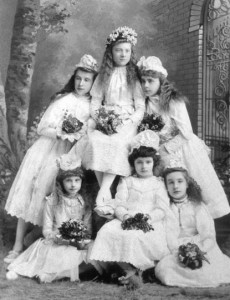The Annotated Decemberists No. 4: “Angel, Won’t You Call Me?”
 Perhaps no band’s lyrics better lend themselves to pseudo-academic analysis than those of The Decemberists. The Annotated Decemberists is an attempt to puzzle through the Portland, Oregon, group’s entire catalog song by song—examining all the obscure vocabulary, historical references and poetic subtext—or go crazy trying.
Perhaps no band’s lyrics better lend themselves to pseudo-academic analysis than those of The Decemberists. The Annotated Decemberists is an attempt to puzzle through the Portland, Oregon, group’s entire catalog song by song—examining all the obscure vocabulary, historical references and poetic subtext—or go crazy trying.
Not all of Colin Meloy’s songs are dense, historical narratives. “Angel, Won’t You Call Me?” is a cute, short, (relatively) simple pop song. The narrator’s relationship to this “Angel” is not explained in detail and therefore left open to interpretation, but basically we have a fairly straightforward musical love letter—albeit one couched in plenty of self-deprecation.
“Angel, Won’t You Call Me?”
From 5 Songs (2001, re-released 2003)
Angel, won’t you call me?
Could I be the only
though I am a lost cause[1],
Angel, won’t you call me?

Waiting for a sweet breeze,
read it in the tea-leaves[2]
Saw them crown you May Queen[3]
Heard you sing the sweetest thing[4]
But I been so unbridled[5]
I fled at the face of my rival
when I felt his breath
at the back of my neck[6]
Angel, won’t you call me?
So here I am in corduroy[7]
Catch it in your Polaroid[8]
Thought it was an off night,
caught in such a warm light
But, Angel, won’t you call me?
Could I be the only
though I am a lost cause
Angel, won’t you call me?
But I been so unbridled
I fled at the face of my rival
when I felt his breath
at the back of my neck
Angel, won’t you call me?
- This reminds me of the narrator from “Shiny” referring to himself “a dull and witless boy.”↑
- The Encyclopedia of Occultism and Parapsychology describes “Tea Leaves, Divination by” as “one of the most popular forms of fortune-telling” and describes how it works (or “works”): “After a cup of tea has been poured, without using a tea strainer, the tea is drunk or poured away. The cup should then be shaken well and any remaining liquid drained off in the saucer. The diviner now looks at the pattern of tea leaves in the cup and allows the imagination to play around the shapes suggested by them. They might look like a letter, a heart shape, a ring, etc. These shapes are then interpreted intuitively or by means of a fairly standard system of symbolism, such as: snake (enmity or falsehood), spade (good fortune though industry), mountain (journey or hindrance), house (changes, success), etc.” It does not describe how a mound of wet tea leaves that looks like a mountain differs from a mound of wet tea leaves that looks like a house.↑
- “A girl chosen to be queen of the merrymakers on May Day and crowned with flowers.” Celebrated on May 1, May Day is an ancient celebration marking the end of the winter and the beginning of the farming season, and is thus associated with spring, youth and fertility.↑
- I’ve always wondered whether “the sweetest thing” was referring to the song by U2 originally released as a B-side in 1987 and charting around the globe in 1998 as the lead single from the compilation The Best of 1980–1990, but since the phrase isn’t capitalized (according to the official lyrics at decemberists.com), I don’t think that’s the case. “Angel” probably doesn’t refer to “Angel of Harlem,” either.↑
- “adj. 1. having no bridle on: said of a horse, etc. 2 unrestrained; uncontrolled”↑
- The idiom “breathing down my neck” can mean either that someone is critically supervising you, i.e. a boss constantly looking over your shoulder, or in close competition with you, i.e. a marathon runner so close to passing you that you can literally feel him breathing behind you. Because of the rivalry alluded to earlier in the chorus, I think the latter is the more appropriate interpretation. In other words, as soon as the narrator realized someone else was vying for this girl’s attentions, he gave up the chase, yet he still longs for her.↑
- Though it is mentioned in only two songs, corduroy is the unofficial fabric of The Decemberists. Its old-timey comfort and so-nerdy-it’s-hip fashion status goes with irony-rich, historically minded folk-rock the same way black leather goes with heavy metal. It’s a metaphor not lost on writers looking to sum up all the band’s sensibilities.↑
- Ten years after this song was recorded, The Decemberists’ fascination with obsolete instant-camera technology reached its logical culmination when the band hatched a scheme to have longtime photographer Autumn de Wilde document the recording of The King is Dead entirely with Polaroids. After securing a donation of self-developing prints from The Impossible Project, a group devoted to maintaining a supply of film for Polaroid enthusiasts, de Wilde took 2,500 pictures of the band, one of which was included in each of the 2,500 Deluxe Box Editions of the album.↑